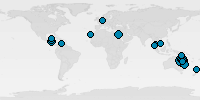
Exmouth and Ningaloo Reef, the world's longest fringing reef, are known for its excellent chances to dive with whale sharks.
| Inserted/Added by: | lars, © Author: Lars Hemel |
| Rated: | Rated 3.5, 32 votes |
Send us your images for this dive region[Add Image][Add Movie]
Ningaloo Reef near Exmouth is known as the world's largest fringing reef and second largest Marine Park in Australia. It is a 260km long fringing reef starting at Bundegi Reef, Exmouth Gulf all the way around the North West Cape, Ningaloo, Maud's Landing, to Amherst Point, Coral Bay. A shallow protected lagoon is formed between the reef and shore with a wide diversity of coral and marine species, all because of the warm Leeuwin Current which runs southward and brings in warm tropical waters. There are places where the reef starts within 100 meters from shore.
The small town Exmouth used to be a joint Australian - American navy base, starting in 1967, until the Americans left and tourism started to pick up. Game fishing for grouper, snapper and tuna is popular as are water activities such as sea kayaking, windsurfing and beaching. This close to the outback you can also book a 4wheel drive towards Cape Range National Park and its red rocks. For those interested in the Ningaloo Reef without getting wet, you can book a semi-submersible cruise tour. Learmonth Airport is only 35km south and makes it a destination easily reached.
The climate is tropical warm with sea water temperatures in the high and low twenties depending on the season. Ningaloo Coral Reef is "home of the Gentle Giant" with humpback whales (Jun-Sep) and whale sharks (Apr-Jul) migrating north and south. Other marine species attracted to this nutrient rich area are manta rays (May-Nov) and the rare and shy dugongs (May-Aug). Turtles mate and lay their eggs from November until January and they are hatched in February. Its warm pristine waters, white sand and excellent coral formations have made it home to hundreds of different species of fish and one of the best spots for macro photography. Its shallow dive sites, coral boulders, often accessible from shore, are brilliant for snorkeling and diving. One of the best known spots is Navy Pier, a great aquarium and muck diving destination reached from shore with millions of juvenile fish and some of the best corals.
[Add Message]Messages from readers:
[Add Divelog]Divelogs from members:
